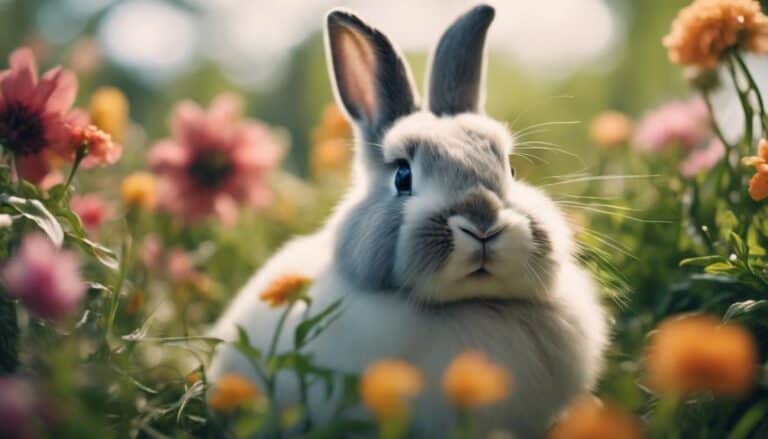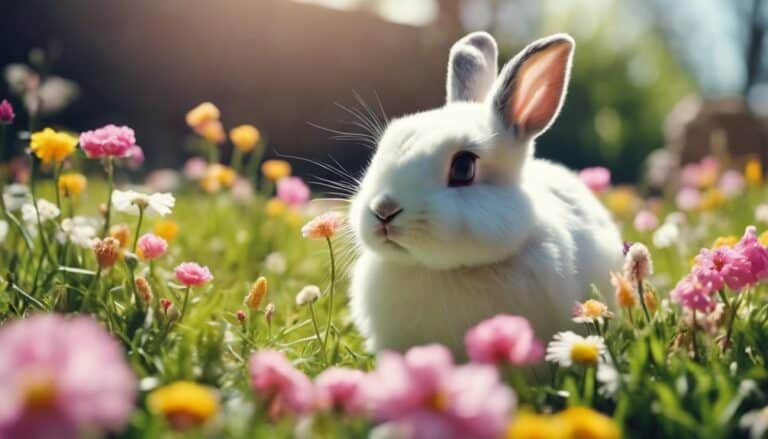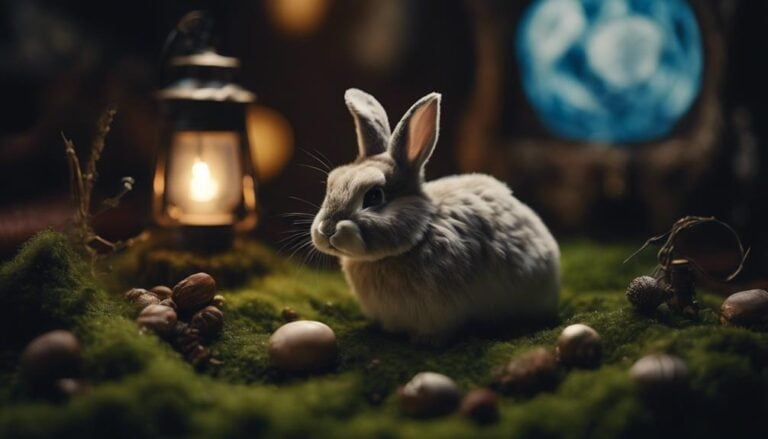When considering Native American folklore, the rabbit emerges as a mesmerizing figure steeped in symbolism and significance across various tribes and cultures.
From embodying wit and wisdom to serving as a symbol of abundance and fertility, the rabbit's presence in indigenous narratives offers a window into profound teachings and cultural values.
As you explore the intricate tapestry of rabbit symbolism in Native American traditions, you'll uncover layers of meaning that resonate deeply with the natural world and human experience, inviting you to reflect on the interconnectedness between folklore, spirituality, and life itself.
Contents
- 1 Key Takeaways
- 2 Native American Rabbit Symbolism Overview
- 3 Rabbit Symbolism in Ojibwe Culture
- 4 Rabbit Symbolism in Cherokee Tradition
- 5 Kokopelli and Rabbit Symbolism
- 6 How Rabbit Stole Otter's Coat
- 7 Rabbit Clans in Native American Folklore
- 8 The Rabbit in Aztec Mythology
- 9 Rabbit Symbolism in Southwestern Tribes
- 10 Frequently Asked Questions
- 11 Conclusion
Key Takeaways
- Rabbit symbolizes fertility, renewal, and agility in Native American folklore.
- It embodies adaptability, intelligence, and prosperity, reflecting wisdom and guidance.
- Rabbit's presence signifies interconnectedness, unity, and cultural teachings in tribes.
- Kokopelli fusion with rabbit symbolizes abundance, prosperity, and nature's reverence.
Native American Rabbit Symbolism Overview
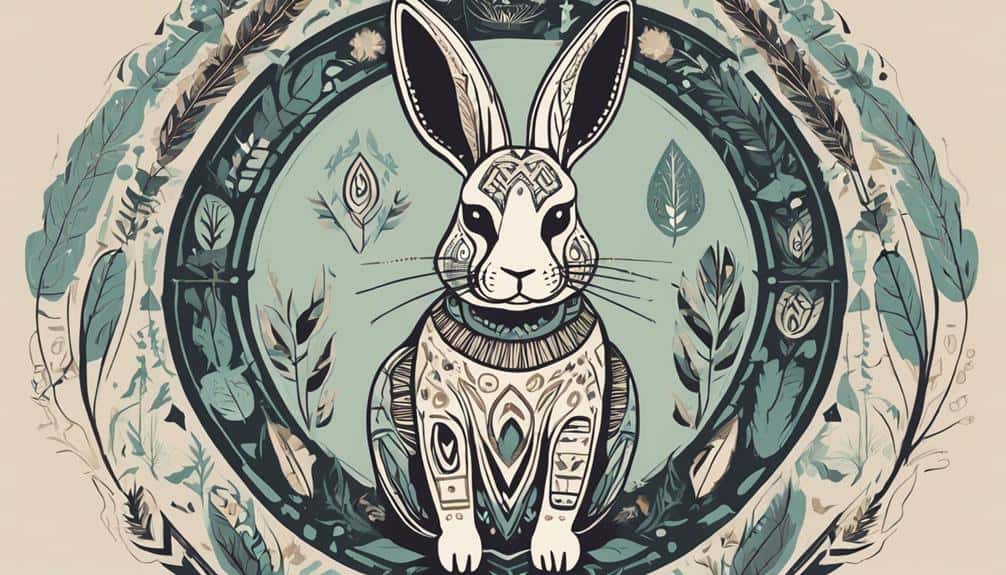
Delving into the intricate tapestry of Native American folklore, exploring the profound symbolism of the rabbit reveals a rich tapestry of meanings and significance. Within Native American cultures, the rabbit holds a special place as a symbol of fertility and renewal. It embodies qualities such as agility and intuition, traits highly valued in many tribes. The rabbit isn't just a physical creature but also carries deep spiritual meanings, often associated with trickster figures like Nanabozho and Michabo.
In various Native American traditions, the rabbit is revered for its ability to navigate different terrains with ease, symbolizing adaptability and intelligence. Its role as a trickster in Cherokee folklore showcases how the rabbit imparts valuable lessons through its cleverness. Additionally, the rabbit is seen as a harbinger of prosperity and abundance, emphasizing the interconnectedness of all living beings in the circle of life. Overall, the rabbit's symbolism in Native American cultures underscores the importance of embracing change, learning from challenges, and recognizing the cyclical nature of existence.
Rabbit Symbolism in Ojibwe Culture
In Ojibwe culture, the rabbit holds significant symbolism tied to the cultural hero Nanabozho. Nanabozho's portrayal as a clever trickster embodies the rabbit's transformative and intelligent qualities.
Through rabbit stories, the Ojibwe convey messages of adaptability, wit, and the interconnectedness between nature and humanity.
Ojibwe Rabbit Stories
With a rich cultural heritage rooted in reverence for nature and storytelling, Ojibwe Rabbit Stories illuminate the significance of the rabbit as a symbol in Ojibwe culture. The rabbit is closely associated with Nanabozho, a key figure in Ojibwe folklore embodying fertility and abundance.
Nanabozho, depicted as a rabbit, is revered as a benign trickster, imparting wisdom and guidance through tales passed down through generations. These stories often convey moral lessons, teaching values through Nanabozho's clever and resourceful actions.
The Ojibwe tradition portrays the rabbit as a figure of resilience and adaptability, showcasing the importance of these traits in maneuvering life's challenges. Through Ojibwe Rabbit Stories, the rabbit symbolizes not only creativity and intelligence but also the resilience needed to thrive in the face of adversity.
Rabbit Symbolic Traits
Ojibwe Rabbit Stories showcase the rabbit as a symbol of cleverness, agility, and adaptability in Ojibwe culture, embodying traits of intelligence and cunning revered for its trickster qualities. In Ojibwe culture, the rabbit symbolizes more than just a fluffy animal; it represents profound lessons and values. Here are key traits associated with the rabbit in Ojibwe folklore:
- Trickster Qualities: The rabbit's ability to outsmart others highlights its mischievous yet clever nature.
- Wisdom: Through its actions, the rabbit imparts wisdom and teaches important life lessons.
- Adaptability: The rabbit's agility and quick thinking symbolize the importance of adjusting to different situations.
- Guidance: Ojibwe people view the rabbit as a guide, offering insights on handling life's challenges with wit and wisdom.
Rabbit Symbolism in Cherokee Tradition
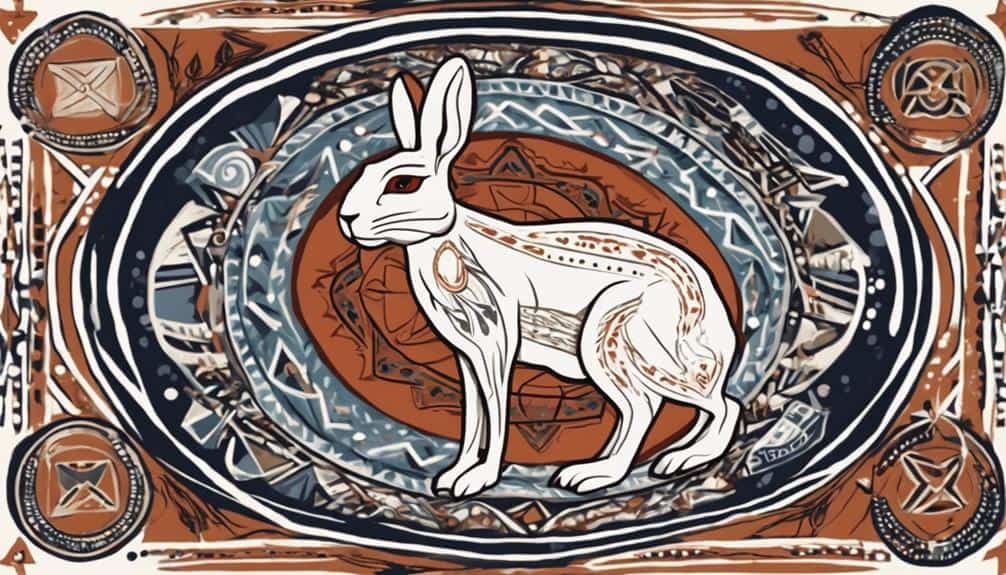
Often depicted as a trickster figure in Cherokee tradition, the rabbit embodies intelligence, quick thinking, and adaptability in managing life's challenges. In Cherokee folklore, the rabbit serves as a symbol of cunning and resourcefulness, outsmarting others through its wit and cleverness. Through stories passed down through generations, the rabbit's role as a trickster highlights the importance of strategy and cleverness in overcoming obstacles.
Kokopelli and Rabbit Symbolism
In Cherokee tradition, where the rabbit symbolizes wit and cleverness, the figure of Kokopelli emerges as a flute player often depicted as a rabbit, embodying themes of fertility, prosperity, and abundance in Native American art and culture. This fusion of Kokopelli and rabbit symbolism creates a powerful representation of interconnected meanings within Native American folklore.
Here are four interesting facts about Kokopelli and rabbit symbolism:
- Cultural Fusion: Kokopelli, with his roots in various Native American tribes, showcases how different cultures intertwine, forming a rich tapestry of beliefs and traditions.
- Fertility Symbolism: Both Kokopelli and the rabbit symbolize fertility, emphasizing the importance of growth and abundance in Native American societies.
- Artistic Expression: The imagery of Kokopelli as a flute-playing rabbit highlights the creativity and artistry present in Native American depictions of cultural icons.
- Spiritual Significance: Kokopelli's role in ceremonies and stories underscores his spiritual importance, guiding Native American communities in rituals related to fertility and prosperity.
How Rabbit Stole Otter's Coat
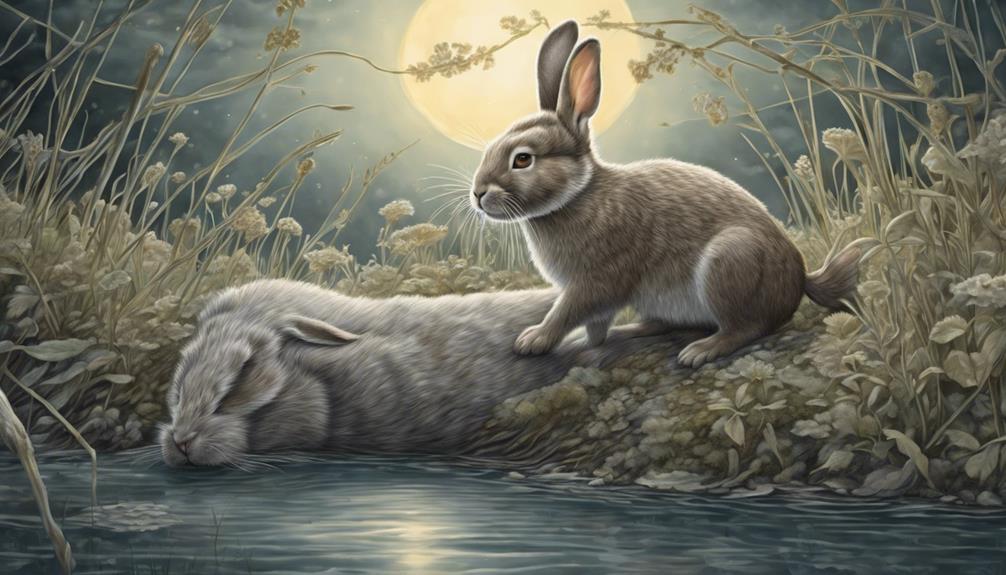
Rabbit's cunning and resourcefulness shone brightly in the Native American folklore tale of how he managed to trick Otter into swapping their coats. In this story of Rabbit trickery, Otter's sleek coat, so coveted by Rabbit for its warmth and style, became the object of his desire. With his cleverness and cunning nature on full display, Rabbit devised a plan to outsmart Otter and claim the prized coat as his own.
This narrative not only showcases Rabbit's resourcefulness but also emphasizes themes of trickery, ingenuity, and consequences often found in Native American storytelling. Through Rabbit's actions, the tale teaches lessons about the consequences of deceit and the rewards of quick thinking. It highlights the importance of wit and strategy in overcoming challenges, even when faced with seemingly impossible odds.
In the domain of Native American folklore, Rabbit's escapades serve as a reminder of the power of intelligence and cunning in navigating the complexities of life.
Rabbit Clans in Native American Folklore
Rabbit clans in Native American folklore play a significant role within tribes like the Hopi and Shawnee, embodying a spiritual connection to specific animal guardians. These clans are deeply intertwined with the cultural fabric of these tribes, symbolizing unity and reverence for nature.
- Spiritual Significance: Rabbit clans aren't just social units within tribes; they hold a sacred place in Native American spirituality, representing harmony with the natural world.
- Animal Guardians: Each clan is associated with an animal guardian, with the rabbit being a prevalent choice. This connection signifies protection, guidance, and wisdom.
- Sacred Rabbit Dance: Northeastern and Northern Plains tribes perform the sacred Rabbit Dance as part of their traditions. This dance is a symbolic representation of cultural significance and unity within the community.
- Unity and Connection: Through Rabbit clans and the sacred dance, tribes express their deep respect and spiritual connection to animals, fostering a sense of unity and harmony with the world around them.
The Rabbit in Aztec Mythology
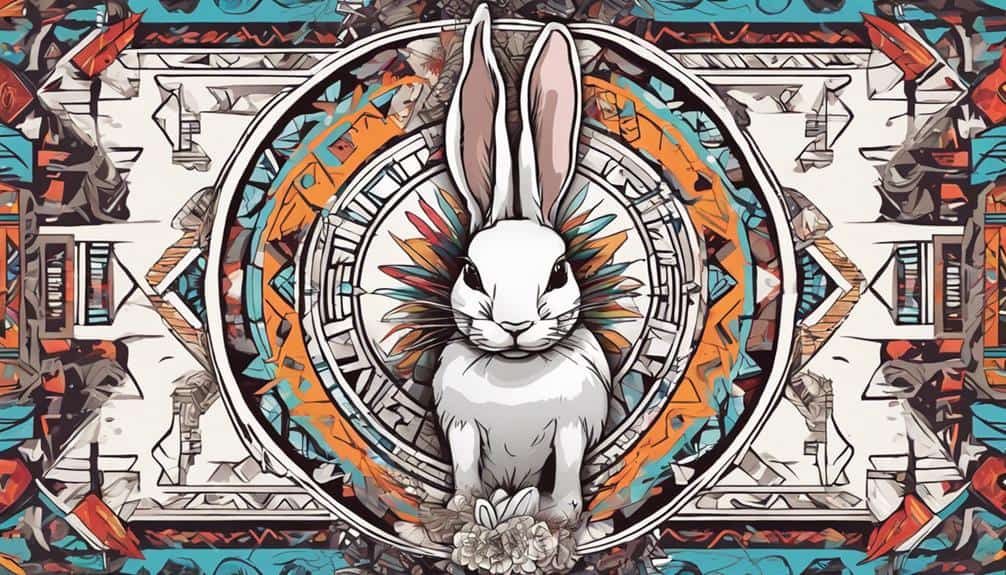
The rabbit's symbolism in Aztec mythology transcends mere representation, delving into domains of fertility, revelry, and divine narratives. Aztecs revered the rabbit as a symbol of fertility, associating it with drinking and celebrations. Within Aztec stories, the Centzon Totochtin, a group of 400 rabbit gods, played significant roles. Among them, Macuiltochtli stood out, governing over-indulgence and its consequences, reflecting the Aztec belief in balance and moderation.
An intriguing legend explains the presence of a rabbit in the moon, involving the benevolent actions of the god Quetzalcoatl. In this tale, the rabbit selflessly offers itself as food to the god, who, moved by the gesture, immortalizes the rabbit in the moon. This narrative illustrates themes of sacrifice, nobility, and the interconnectedness of the divine and earthly domains in Aztec cosmology.
The rabbit's presence in Aztec mythology serves as a reminder of the intricate tapestry of beliefs and values woven into their cultural heritage.
Rabbit Symbolism in Southwestern Tribes
Symbolizing fertility, rain, and prosperity in Southwestern tribes, the rabbit holds a revered place in their cultural narratives and artistic expressions. Here are some insights into the rabbit symbolism in Southwestern tribes:
- Fertility and Abundance: The rabbit is celebrated for its connection to fertility and abundance in nature. Southwestern tribes view the rabbit as a symbol of new life, growth, and the flourishing of communities.
- Bringing Rain: The rabbit is often associated with rain-bringing ceremonies in Southwestern tribes. Its presence signifies the potential for rainfall, essential for agricultural success and sustaining life in arid regions.
- Harmony with Nature: Rabbit symbolism underscores the importance of living in harmony with nature. Southwestern tribes recognize the rabbit as a reminder of respecting the cycles of life, embracing sustainability, and honoring the interconnectedness of all living beings.
- Community Well-being: Through their folklore and teachings, Southwestern tribes emphasize the rabbit's role in ensuring the well-being of the community. The rabbit symbolizes cooperation, shared prosperity, and the mutual support necessary for thriving together in harmony with nature.
Frequently Asked Questions
What Do Rabbits Symbolize in Native American Culture?
Rabbits symbolize fertility, abundance, and prosperity in Native American culture. They embody cultural significance, mythological connections, traditional beliefs, and symbolic interpretations. Their presence reflects wisdom, resourcefulness, and the essence of clever tricksters.
What Is the Rabbit in Native American Folklore?
In Native American folklore, the rabbit is a multifaceted symbol. It serves as a trickster, messenger, protector, and symbol of intelligence. Embodying fertility, prosperity, and lessons learned, the rabbit's presence in stories adds depth and complexity.
What Do Rabbits Symbolize in Folklore?
In folklore, rabbits symbolize abundance, fertility, and agility. Their cultural significance lies in representing growth, renewal, and wisdom. Folklore interpretations connect rabbits with prosperity and rain, while spiritual connections highlight their adaptability and transformative nature.
What Does Seeing a Rabbit Mean Spiritually?
When you see a rabbit spiritually, it serves as a guide for your inner growth and intuition. It signifies manifestation, abundance, and a connection to fertility. Embrace the wisdom of this animal totem for spiritual guidance.
Conclusion
As you explore on the intricate web of Native American folklore surrounding the rabbit, you may find yourself drawn into a world of wisdom and symbolism that transcends time.
The rabbit's role as a trickster, symbol of fertility, and bearer of important life lessons serves as a reminder of the profound connections between nature, culture, and spirituality.
Investigate further into these rich traditions to uncover the hidden treasures of wisdom and insight waiting to be discovered.




